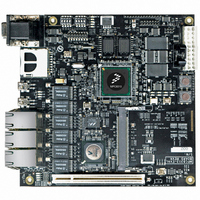MPC8313E-RDB Freescale Semiconductor, MPC8313E-RDB Datasheet - Page 87

MPC8313E-RDB
Manufacturer Part Number
MPC8313E-RDB
Description
BOARD PROCESSOR
Manufacturer
Freescale Semiconductor
Series
PowerQUICC II™ PROr
Type
MCUr
Datasheets
1.MPC8313CZQAFFB.pdf
(100 pages)
2.MPC8313E-RDBB.pdf
(52 pages)
3.MPC8313E-RDBB.pdf
(2 pages)
Specifications of MPC8313E-RDB
Contents
Reference Design Board, Software and Documentation
Termination Type
SMD
Supply Voltage Max
1.05V
Tool / Board Applications
Wired Connectivity-LIN, CAN, Ethernet, USB
Mcu Supported Families
POWERQUICC II PRO
Rohs Compliant
Yes
Filter Terminals
SMD
Silicon Manufacturer
Freescale
Silicon Core Number
MPC83xx
Kit Application Type
Communication & Networking
Application Sub Type
Ethernet
Core Architecture
Power Architecture
Silicon Family Name
PowerQUICC II PRO
For Use With/related Products
MPC8313E
Lead Free Status / RoHS Status
Lead free / RoHS Compliant
21.3
When attaching heat sinks to these devices, an interface material is required. The best method is to use
thermal grease and a spring clip. The spring clip should connect to the printed-circuit board, either to the
board itself, to hooks soldered to the board, or to a plastic stiffener. Avoid attachment forces which would
lift the edge of the package or peel the package from the board. Such peeling forces reduce the solder joint
lifetime of the package. Recommended maximum force on the top of the package is 10 lb (4.5 kg) force.
If an adhesive attachment is planned, the adhesive should be intended for attachment to painted or plastic
surfaces and its performance verified under the application requirements.
21.3.1
When heat sink is used, the junction temperature is determined from a thermocouple inserted at the
interface between the case of the package and the interface material. A clearance slot or hole is normally
required in the heat sink. Minimizing the size of the clearance is important to minimize the change in
thermal performance caused by removing part of the thermal interface to the heat sink. Because of the
experimental difficulties with this technique, many engineers measure the heat sink temperature and then
back calculate the case temperature using a separate measurement of the thermal resistance of the
interface. From this case temperature, the junction temperature is determined from the junction to case
thermal resistance.
where:
Freescale Semiconductor
The Bergquist Company
18930 West 78th St.
Chanhassen, MN 55317
Internet: www.bergquistcompany.com
T
T
R
P
J
C
θ
D
Heat Sink Attachment
JC
= junction temperature (°C)
= case temperature of the package
= power dissipation
Experimental Determination of the Junction Temperature with a
Heat Sink
= junction-to-case thermal resistance
T
J
= T
MPC8313E PowerQUICC
C
+ (R
θ
JC
x P
D
)
™
II Pro Processor Hardware Specifications, Rev. 3
800-347-4572
Thermal
87











